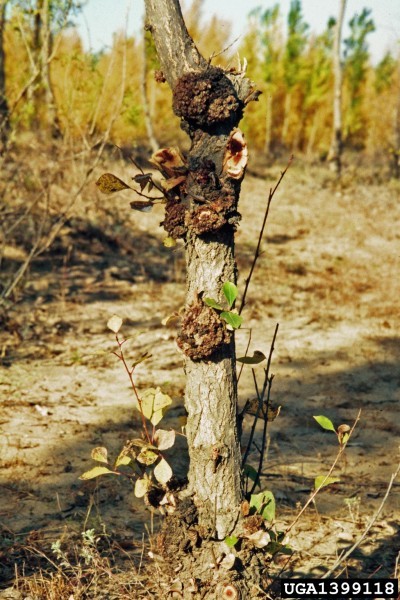






Before you decide to start crown gall treatment, consider the value of the plant you are treating. The bacteria that causes crown gall disease in plants persists in the soil as long as there are susceptible plants in the area. To eliminate the bacteria and prevent the spread, it’s best to remove and destroy diseased plants.
When learning about crown gall treatment, it helps to know more about what is crown gall in the first place. Plants with crown gall have swollen knots, called galls, near the crown and sometimes on the roots and twigs as well. The galls are tan in color and may be spongy in texture at first, but they eventually harden and turn dark brown or black. As the disease progresses, the galls can totally encircle the trunks and branches, cutting off the flow of sap that nourishes the plant.
The galls are caused by a bacterium (Rhizobium radiobacter formerly Agrobacterium tumefaciens) that lives in the soil and enters the plant through injuries. Once inside the plant, the bacterium injects some of its genetic material into the host’s cells, causing it to produce hormones that stimulate small areas of rapid growth.
Unfortunately, the best course of action for plants affected by crown gall is to remove and destroy the infected plant. The bacteria can persist in the soil for two years after the plant is gone, so avoid planting any other susceptible plants in the area until the bacteria dies out for lack of a host plant.
Prevention is an essential aspect of dealing with crown gall. Inspect plants carefully before you buy them, and reject any plants with swollen knots. The disease can enter the plant in the nursery through the graft union, so pay particular attention to this area.
To prevent the bacteria from entering the plant once you get it home, avoid wounds near the ground as much as possible. Use string trimmers with care and mow the lawn so that debris flies away from susceptible plants.
Galltrol is a product that contains a bacterium that competes with Rhizobium radiobacter and prevents it from entering wounds. A chemical eradicant called Gallex may also help prevent the crown gall disease in plants. Although these products are sometimes recommended for crown gall treatment, they are more effective when used as a preventative before the bacteria infects the plant.
Over 600 different plants are affected by crown gall, including these common landscape plants:
Copyright © www.100flowers.win Botanic Garden All Rights Reserved